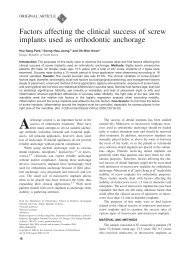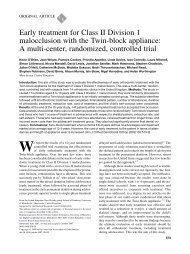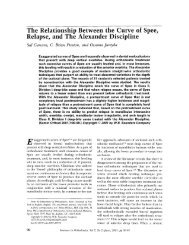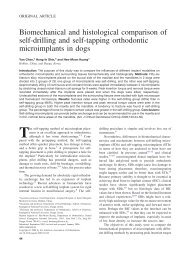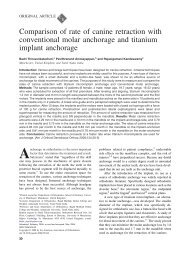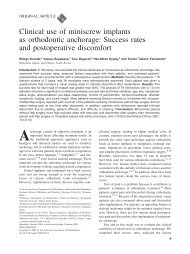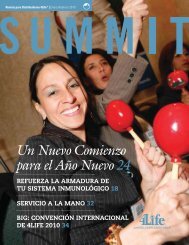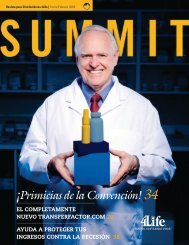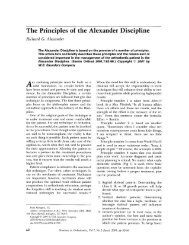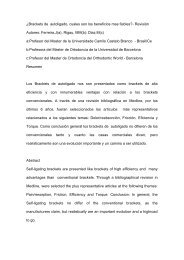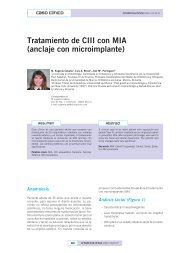Leveling the curve of Spee with a continuous archwire technique: A ...
Leveling the curve of Spee with a continuous archwire technique: A ...
Leveling the curve of Spee with a continuous archwire technique: A ...
Create successful ePaper yourself
Turn your PDF publications into a flip-book with our unique Google optimized e-Paper software.
American Journal <strong>of</strong> Orthodontics and Dent<strong>of</strong>acial Orthopedics<br />
Volume 131, Number 3<br />
Bernstein, Preston, and Lampasso 369<br />
structural method, 49 to measure <strong>the</strong> treatment-induced<br />
changes in dental heights. Whereas this <strong>technique</strong> was<br />
suitable for measuring changes in <strong>the</strong> mandibular incisor<br />
region (L1-MP), it produced method errors that<br />
were unacceptably large for <strong>the</strong> o<strong>the</strong>r 2 dimensions<br />
studied (L4-MP and L6-MP).<br />
Our results indicate that most <strong>of</strong> <strong>the</strong> leveling <strong>of</strong> <strong>the</strong><br />
COS was accomplished by relative extrusion <strong>of</strong> <strong>the</strong><br />
premolars (mean, 2.81 mm) as measured by <strong>the</strong> L4-MP<br />
perpendicular distance (Table III). It is, however, likely<br />
that some <strong>of</strong> <strong>the</strong> mean increase in this dimension could<br />
be attributed to bone apposition at <strong>the</strong> inferior border <strong>of</strong><br />
<strong>the</strong> mandible. Without control growth data for Class II<br />
subjects, we decided to use <strong>the</strong> growth charts derived<br />
from normal white American youths. In support <strong>of</strong> <strong>the</strong><br />
use <strong>of</strong> normal growth data, our selection criteria favored<br />
subjects <strong>with</strong> normal to shorter-than-average<br />
lower anterior facial heights as measured by <strong>the</strong> MP to<br />
SN angle (32°). The appositional growth in <strong>the</strong><br />
premolar area was taken to be <strong>the</strong> average <strong>of</strong> <strong>the</strong><br />
available mean growth increments <strong>of</strong> <strong>the</strong> molar and<br />
incisor regions. 36 In this study, <strong>the</strong> mean contribution<br />
<strong>of</strong> growth to <strong>the</strong> L4-MP perpendicular distance was<br />
calculated as 1.55 mm.<br />
36 If this estimated growth is<br />
taken into account, <strong>the</strong>n <strong>the</strong> mean net extrusion <strong>of</strong> <strong>the</strong><br />
premolar was 1.26 mm. Likewise, taking appositional<br />
36<br />
growth (1.7 mm) into account, it can be said that<br />
during treatment <strong>the</strong> mean change in <strong>the</strong> L6-MP dis-<br />
36<br />
tance was 0.61 mm. Allowing for growth (1.4 mm)<br />
from T1 to T2, <strong>the</strong> perpendicular distance L1-MP<br />
decreased by a mean <strong>of</strong> –0.87 mm. The premolar and<br />
incisor changes were statistically significant (P .01)<br />
before and after <strong>the</strong> possible effects <strong>of</strong> growth were<br />
taken into account. These findings agree <strong>with</strong> previous<br />
studies suggesting that straight-wire <strong>technique</strong>s level<br />
<strong>the</strong> COS by a combination <strong>of</strong> premolar extrusion and<br />
incisor intrusion. 4,5,19,46 Those studies did not, how -<br />
ever, provide data to quantify <strong>the</strong> suggested tooth<br />
movements.<br />
The relapse <strong>of</strong> <strong>the</strong> COS (T3-T2), although small,<br />
was none<strong>the</strong>less statistically significant (P .01). The<br />
mean observed relapse in <strong>the</strong> COS could be attributed<br />
to changes in <strong>the</strong> relative vertical heights <strong>of</strong> 2 <strong>of</strong> <strong>the</strong><br />
dental elements that were used to define <strong>the</strong> <strong>curve</strong>.<br />
Taking posttreatment growth changes into consideration,<br />
<strong>the</strong> mandibular incisor (L1-MP) erupted a mean<br />
distance <strong>of</strong> 0.66 mm, whereas <strong>the</strong> molar erupted a mean<br />
distance <strong>of</strong> 0.23 mm after treatment. The premolar,<br />
however, had no additional mean vertical dental height<br />
change after treatment and thus had no relapse. These<br />
results confirm previous findings <strong>of</strong> a slight return <strong>of</strong><br />
<strong>the</strong> COS after treatment.<br />
19-21,27<br />
<strong>archwire</strong> mechanics.<br />
Several authors noted <strong>the</strong> effects <strong>of</strong> <strong>continuous</strong><br />
3-9 These effects include flaring <strong>of</strong><br />
<strong>the</strong> mandibular incisors, extrusion <strong>of</strong> <strong>the</strong> mandibular<br />
molars, and clockwise opening rotation <strong>of</strong> <strong>the</strong> OP.<br />
Some features <strong>of</strong> <strong>the</strong> <strong>continuous</strong> arch <strong>technique</strong>, including<br />
<strong>the</strong> –5° <strong>of</strong> torque in <strong>the</strong> mandibular incisors and <strong>the</strong><br />
–6° <strong>of</strong> distal tip in <strong>the</strong> mandibular molars, are somewhat<br />
unique to this <strong>technique</strong>. These features, along<br />
<strong>with</strong> heat-treated stainless steel <strong>archwire</strong>s <strong>with</strong> reverse<br />
COS in <strong>the</strong> mandibular arch and omega stops tied back<br />
to <strong>the</strong> molar tubes, might play a role in preventing <strong>the</strong><br />
side effects reported <strong>with</strong> o<strong>the</strong>r straight-wire <strong>technique</strong>s.<br />
3-9<br />
All subjects in this study had mild to moderate<br />
mandibular incisor crowding that, <strong>with</strong> a straight<br />
wire and a nonextraction approach to treatment,<br />
would have been aggravated by <strong>the</strong> leveling <strong>of</strong> <strong>the</strong><br />
COS. 39 Despite <strong>the</strong> incisor crowding in our sample <strong>of</strong><br />
patients, <strong>the</strong> effects <strong>of</strong> <strong>the</strong> orthodontic treatment on <strong>the</strong><br />
position <strong>of</strong> <strong>the</strong>ir mandibular incisors were minimal. The<br />
angles (L1-NB, L1-MP) were not statistically significantly<br />
changed as a result <strong>of</strong> treatment (P .01). The<br />
mean treatment change <strong>of</strong> <strong>the</strong> significantly (P .01)<br />
altered variable (L1 to A-Po) was 1.51 1.57 mm.<br />
Because <strong>the</strong> T1 average position for <strong>the</strong> L1 to A-Po was<br />
–1.18 mm, a mean proclination <strong>of</strong> 1.51 mm placed <strong>the</strong><br />
tip <strong>of</strong> <strong>the</strong> L1 ahead <strong>of</strong> <strong>the</strong> A-Po line by a mean <strong>of</strong> 0.33<br />
mm. It is thus fair to say that, in this sample, orthodontic<br />
treatment did not result in excessive flaring <strong>of</strong> <strong>the</strong><br />
mandibular incisors.<br />
Since <strong>the</strong>re was very little alteration in <strong>the</strong> measures<br />
<strong>of</strong> <strong>the</strong> mean positions <strong>of</strong> <strong>the</strong> mandibular incisors during<br />
treatment, it was expected that little posttreatment<br />
change would occur. This was indeed <strong>the</strong> case; <strong>the</strong><br />
posttreatment changes in <strong>the</strong> 3 measurements <strong>of</strong> mandibular<br />
incisor position studied here were small and not<br />
statistically significant (P .01). The L1 to A-Po<br />
distance relapsed an average <strong>of</strong> –0.10 mm to leave <strong>the</strong><br />
tip <strong>of</strong> L1 just 0.23 mm ahead <strong>of</strong> <strong>the</strong> A-Po line. Both<br />
<strong>the</strong> T2 and <strong>the</strong> T3 recordings for <strong>the</strong> L1 to A-Po<br />
distance were close to <strong>the</strong> stated ideal position <strong>of</strong> this<br />
parameter. 46 In this group <strong>of</strong> patients, it can be - con<br />
cluded that <strong>the</strong> treatment-induced average advancement<br />
<strong>of</strong> <strong>the</strong> mandibular incisor was clinically acceptable and<br />
stable in <strong>the</strong> long term.<br />
From <strong>the</strong> data, it appears that <strong>the</strong> mean treatment<br />
change (T2-T1) for <strong>the</strong> mandibular molar inclination to<br />
<strong>the</strong> mandibular plane was –6.42° (SD, 3.04°). This<br />
finding indicates that <strong>the</strong> full 6° <strong>of</strong> tip back built into<br />
<strong>the</strong> molar attachments was expressed in most patients.<br />
The additional 0.42° might have been due to <strong>the</strong> use <strong>of</strong><br />
reverse <strong>curve</strong>d <strong>archwire</strong>s that would tend to cause <strong>the</strong><br />
posterior teeth to tip back even far<strong>the</strong>r than <strong>the</strong> tip<br />
incorporated in <strong>the</strong> prescription <strong>of</strong> <strong>the</strong> appliance. This



